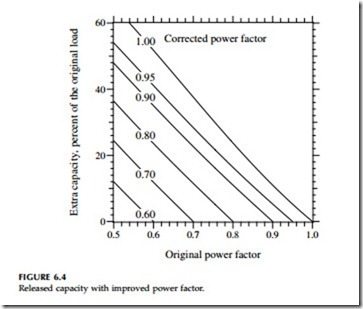Released Capacity
In addition to reducing losses and improving voltage, capacitors release capacity. Improving the power factor increases the amount of real-power load the circuit can supply. Using capacitors to supply reactive power reduces the amount of current in the line, so a line of a given ampacity can
carry more load. Figure 6.4 shows that capacitors release significant capacity, especially if the original power factor is low. Figure 6.5 shows another way to view the extra capacity, as a function of the size of capacitor added.
Related posts:
The power system:Distribution.
Cylinder heads and valves:Combustion chamber types
Cables and Accessories:Installation of Cables
WIND POWER:WIND TURBINE ANATOMY
TIDAL BARRAGE POWER PLANTS
GEOTHERMAL POWER:GEOTHERMAL ENERGY CONVERSION TECHNOLOGIES
Transformers:Preventive Maintenance of Transformers
The Current Situation and Perspectives on the Use of Wind Energy for Electricity Generation:Hungary
Conversion Efficiency Improvement in GaAs Solar Cells:FDTD Software for the Simulation of Nanostruct...
Another Groups of Thermal Optimized Modulation Methods of Three-Level Neutral-Point-Clamped Inverter...
Motors and Generators:Motor and Generator Insulation Systems
Engine mechanics:Scope of work
Medium-Voltage Switchgear and Circuit Breakers:DC (Battery) Control Power Equipment
MARINE POWER GENERATION TECHNOLOGIES:OCEAN THERMAL ENERGY CONVERSION
Batteries and fuel cells:Operation and maintenance.
